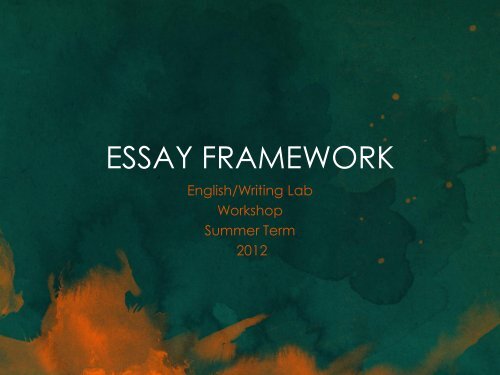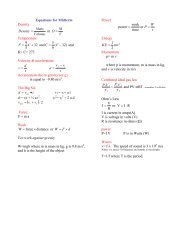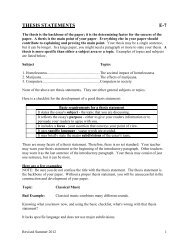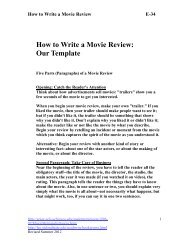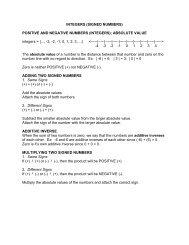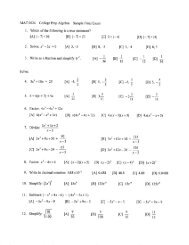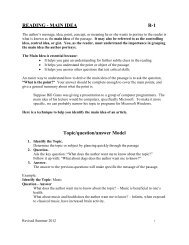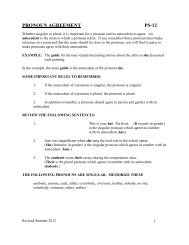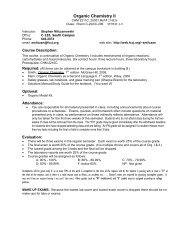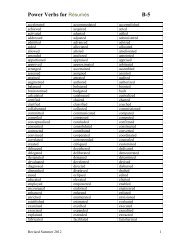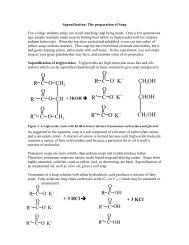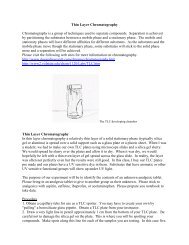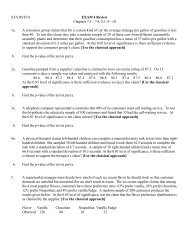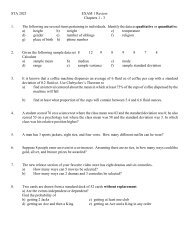ESSAY FRAMEWORK
ESSAY FRAMEWORK
ESSAY FRAMEWORK
- No tags were found...
You also want an ePaper? Increase the reach of your titles
YUMPU automatically turns print PDFs into web optimized ePapers that Google loves.
<strong>ESSAY</strong> <strong>FRAMEWORK</strong>English/Writing LabWorkshopSummer Term2012
OVERVIEWKinds of EssaysResearchingTopic/Thesis StatementOutlinesThe Writing ProcessProofreading/Revising
Knowing your PaperSo, you have a paper to write? What is yourpaper going to be about? Is it going to argue yourpoint of view? Or are you going to describesomething you love to do? What is your paper’spurpose? Whatever the case may be, you need toknow what kind of paper you are going to be writingin order to better prepare yourself for doing so. Beloware some of the basic types of essays you may needto write. Remember that each essay requires differentinformation, but the framework remains similar.DescriptiveNarrativeDefinitionCause/EffectCompare and ContrastArgumentativeExpository/ProcessCritical/Analysis
Researching• Researching is as vital to essay writingas books are vital to the library.• You need to research to narrow downthe topic of your essay.
Topic/ Thesis Statement• From your research youshould form a strongly statedtopic/thesis.• Your topic or thesis statementis what your entire essay isgoing to be about.• You should be able to writeyour Thesis Statement in oneor two sentences.• It should state an opinion oridea, be specific, a strongclear claim, and supportedwith a variety of evidence.
Creating an Outline• Outlining your ideasand thoughts help toorganize your essay, aswell as write it.– You can do this with abasic outline or anyother graphicorganizer you sochoose.• It may even help youget past your Writer’sBlock! How about that?Recommendedfor any type ofessay
Different Types of Graphic Organizershttp://www.eduplace.com/graphicorganizer/Compare/ContrastT-chartVennDiagramSimilaritiesandDifferencesChartArgumentativeProblem-SolutionChartProcess/ExpositorySequenceChartCritical/AnalysisProblem-SolutionChartCluster/Word Web Flow Chart KWL ChartFact and OpinionChartClock ChartISP ChartDescriptive Narrative Definition Cause/EffectObservationChartStory MapFive W’sChartT-chartFive W’s ChartCluster/WordWebDescribingWheelKWLChartDescribing Wheel Tree Chart Tree Chart FlowChart
Writing ProcessWe all know how to put words ontopaper. Is that really writing though?When we write with a purposecertain items are needed. Forinstance, when you write anexpository or process essay you areto inform the reader how to dosomething. You do this by writingthe events that occur in sequentialorder. If you write about making apeanut butter and jelly sandwich,you cannot explain how to spreadthe jelly without first explainingwhat supplies are needed.
Breaking Down the ProcessBody Paragraphs:– Transition – This is to help make the whole essay flowtogether instead of just jumping from one point toanother. (This is where those transitional words come inhandy.)Think about a production line. If one person fallsasleep or a machine breaks, the whole line goes“kaput”.- Main Idea – Each body paragraph has its own idea orcontinues the idea from the previous paragraph. Theidea should be how it relates or “backs up” the thesis.
Body Paragraphs• Sub-points or EvidenceThis supports the main ideas of each ofyour points that support your Thesis.Everything in your essay is dependent oneverything else. Nothing can stand onits own.
Breaking Down the ProcessConclusions:– Sum-up—Go over your paper in itsentirety.– Thesis—Rephrase and restate your thesisto remind the reader what the overallidea of your paper was.– End—Give a nice last sentence thatleaves an impression on the reader.
Proofreading/RevisingAfter you have finished writing your paper, you need tomake sure that you:– Check your content– Check for grammar and spelling errors– If necessary, check your citations’ format (in-text and referencepage).
ContentMake sure you havecovered everything thatyou wanted to and that youhave thoroughly supportedyour thesis.If you don’t support yourthesis, then you do not havemuch of an essay.When you write an essayyou have to be all in.
Grammar and SpellingMake sure you do not have anycomma splices, fragmentedsentences, run-ons, missingcommas, misuses of commasand semicolons, parallelstructure, homonym mix-ups,etc. Also, make sure that youdon’t have any words misspelledor are repetitive with others.Having grammatical orspelling errors can sometimes bedistracting to the reader, whowill then not grasp the entirety ofyour essay.Theses errors are like booboos. If you have so many, theyget really obvious. Cover up orfix those boo boos.
Good PracticeA good way to check for errors is toread your paper aloud. Generally,whenever you breathe, you need tohave some sort of punctuation..
Any Questions?


